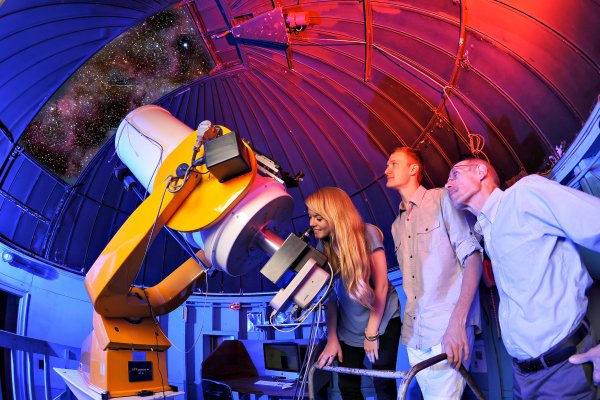Nanoscience
Researching materials one-billionth the size of a meter.
Professor Andrew Richter’s research involves four major components, all firmly within the area of nanoscience:
- using high-intensity x-ray and neutron scattering to study nano-sized materials
- studying the interaction of proteins with organic films
- making and studying organic thin films
- examining artificial liposomes and nanoporous thin films for use in catalysis, sensor, and drug delivery applications, in collaboration with Dr. Pinkhassik at UCONN
To help a general audience understand just how small a nanometer is, the National Nanotechnology Initiative makes the following comparisons:
- A single gold atom is about a third of a nanometer in diameter.
- One nanometer is about as long as your fingernail grows in one second.
- A strand of human DNA is 2.5 nanometers in diameter.
- A sheet of paper is about 100,000 nanometers thick.
- On a comparative scale, if the diameter of a marble was one nanometer, the diameter of the Earth would be about one meter.
Nanomaterials are interesting for a few important reasons:
- Nanoparticles and thin films are almost entirely surfaces, which greatly enhances their reactivity with other molecules.
- Nanoparticles are similar in size to cellular components, making them promising for use in medicine.
- Nanomaterials are more efficient in materials utilization.
- Quantum effects can start having an influence.
Professor Richter has studied organic thin films and their interactions with proteins, using x-ray and neutron techniques to determine the structures of these systems.
Organic films are fairly easy to make and can be used to modify the surface of a material in order to target a specific functionality. Amazingly, these films are typically only one to five nanometers thick — 10 to 50 times the diameter of a hydrogen atom. Yet just this thin layer can dramatically change the behavior of the surface.
For example, clean silicon oxide (the same stuff computer chips are made on) loves water (hydrophilic). But a single molecular layer can be easily grown on it to convert it to repel water (hydrophobic), so hydrophobic that it floats on water instead of sinks. These simple modifications can have profound effects on how proteins interact with surfaces.
Proteins are nature’s nanomachines, performing the required functions of life. Proteins often do their jobs by directly interacting with cell walls, other proteins, and — increasingly — artificial surfaces, such as drug coatings, joint replacements, and stents. Because proteins play vital roles in human health, a large number of research groups are studying how proteins adhere to surfaces.
Professor Richter has looked at protein adsorption onto surfaces, formulating a new measurement technique call in situ x-ray reflectivity, which gives high resolution information about the structure of the protein films, including some time-resolved information as they form.
https://scholar.valpo.edu/phys_astro_fac_pub/34/
Nanocapsules are nanoporous materials with well-defined pore sizes, created using a “biotemplating” technique. They hold great promise for applications ranging from catalysis to drug delivery.
These materials were developed by Eugene Pinkhassik, Ph.D., who is now at UCONN.
Professor Richter’s main contribution to the project is the determination of the structure of the nanomaterials, which is vital for how to design specific pore sizes and shapes for use in particular applications. His team uses neutron and X-ray scattering techniques for this purpose.
When formed into spherical shells (nanocapsules), they are 50 – 200 nm in diameter, but, amazingly, can have shell walls as thin as 1 nm, making them the thinnest engineered polymer material ever created.
The main studies so far have been:
- The way that the liposome scaffolds “load” with the nanocapsule shell material (“monomers”).
- Time-resolved studies of the loading process.
- How changing the type of monomer and the size of the liposome affects the loading process.
- Determining the thickness of the nanocapsule shell walls.
- Evaluating several alternate methods to create the nanocapsule templates.
- The formation and testing of a gold substrate preparation method for making large, flat gold electrodes for nanosensor applications.
- The formation and testing of an ultrathin insulating polymer film that will eventually be made porous for use in nanosensor applications.
- The distribution and structure of nanodisks in solution and in polymer matrices for use as nanocomposite materials.
Future research involves trying to make the nanocapsules biodegradable so they can be used for drug delivery and disease diagnosis. We are also examining how encapsulating enzymes can help protect the enzymes while the catalyze biochemical reactions. And we are studying the material properties of the capsules, such as their elastic moduli and their breaking strength.
